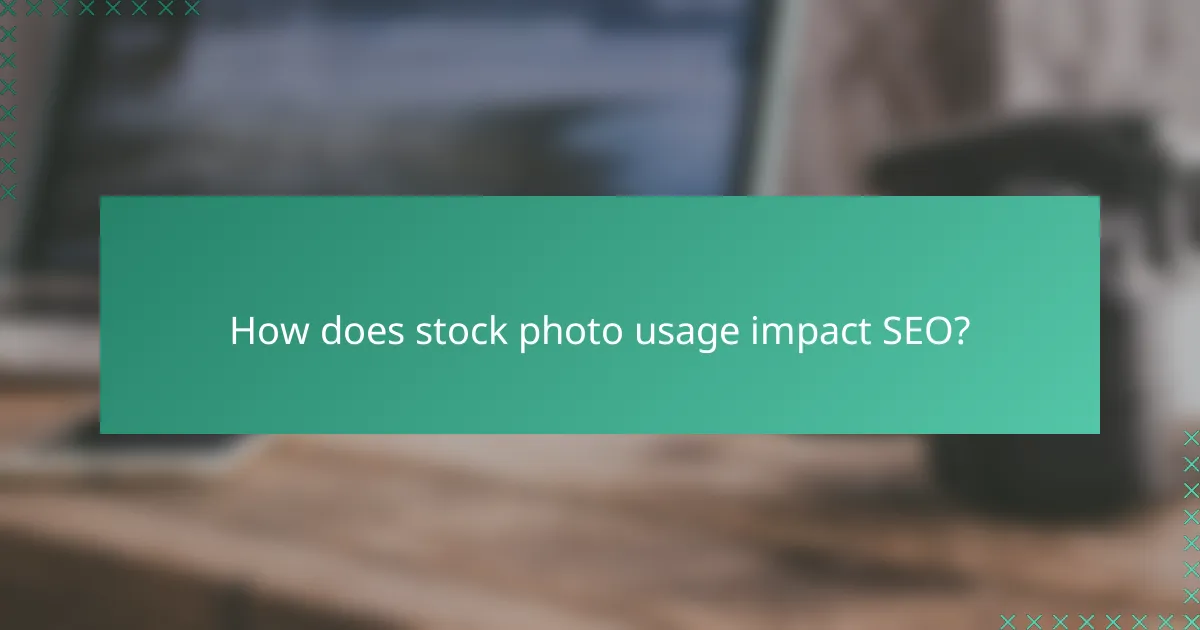Stock photos can be a valuable resource for enhancing visual content, but navigating the complexities of licensing, quality, and overuse can be challenging. Understanding the different licensing types is crucial to ensure legal compliance and budget alignment. Additionally, quality inconsistencies and the risk of overusing popular images can undermine the uniqueness of your projects. By strategically selecting and integrating stock imagery, you can create a distinctive visual identity that resonates with your audience.

How to choose the right stock photo licensing?
Choosing the right stock photo licensing involves understanding the different types available and how they align with your intended use. Each licensing option has specific terms that dictate how you can use the images, which can affect your project’s budget and legal compliance.
Royalty-free licensing
Royalty-free licensing allows you to use a stock photo without paying royalties or licensing fees after the initial purchase. This option is often more cost-effective for projects requiring multiple images, as you can use the photo in various contexts without incurring additional costs.
However, be aware that while you can use these images freely, there may still be restrictions on resale or use in certain contexts, such as merchandise. Always read the specific terms associated with each image to avoid potential issues.
Rights-managed licensing
Rights-managed licensing grants you specific rights to use a stock photo for a defined period and purpose, often at a higher cost than royalty-free options. This type of licensing is beneficial for projects that require exclusivity or a limited usage scope.
When purchasing rights-managed images, consider factors like the duration of use, geographic distribution, and the medium (print, web, etc.). These factors can significantly influence the price, so clarify your needs upfront to avoid overpaying.
Creative Commons licensing
Creative Commons licensing offers a range of options that allow creators to share their work while retaining certain rights. Depending on the specific license, you may be able to use images for free, provided you give appropriate credit and adhere to any restrictions.
Common Creative Commons licenses include those that allow modifications or commercial use, while others may require non-commercial use only. Always check the license type to ensure compliance with the usage terms.
Exclusive vs. non-exclusive licenses
Exclusive licenses grant you sole rights to use a stock photo, meaning no one else can use the same image. This option is typically more expensive but can be worthwhile for brands seeking a unique visual identity.
Non-exclusive licenses, on the other hand, allow multiple users to purchase and use the same image. This option is generally more affordable and suitable for projects where uniqueness is less critical.
Popular platforms for stock photos
Several platforms offer stock photos with varying licensing options. Some of the most popular include Shutterstock, Adobe Stock, and Getty Images, each providing a mix of royalty-free and rights-managed images.
When selecting a platform, consider factors such as image quality, pricing models, and the range of available licenses. Many platforms also offer subscription models that can be cost-effective for frequent users.

What are the common quality issues with stock photos?
Common quality issues with stock photos include resolution and size discrepancies, inconsistent styles across collections, overly edited images, and concerns about source credibility. These factors can significantly affect the usability and effectiveness of stock images in various projects.
Resolution and size discrepancies
Resolution and size discrepancies can lead to images that are either too small for high-quality prints or excessively large for web use. When selecting stock photos, always check the resolution, aiming for at least 300 DPI for print and 72 DPI for web. If the image is intended for a specific platform, ensure it meets the required dimensions to avoid pixelation or unnecessary loading times.
Inconsistent styles across collections
Inconsistent styles across collections can create a disjointed look in projects that require multiple images. Different photographers and contributors may have varying techniques, leading to a mix of aesthetics that clash. When choosing stock photos, consider curating images from the same collection or photographer to maintain a cohesive visual theme.
Overly edited images
Overly edited images can appear unnatural and detract from the intended message. Excessive filters, retouching, or graphic elements can make a photo feel inauthentic. Opt for images that reflect a natural look and feel, as they are more likely to resonate with viewers and convey genuine emotions.
Source credibility
Source credibility is crucial when selecting stock photos, as images from unreliable sources may lack proper licensing or quality assurance. Always choose stock photo websites that are well-known and reputable, ensuring that the images are legally sourced and of high quality. This practice not only protects your project but also supports ethical content creation.

How to avoid overusing stock photos?
To avoid overusing stock photos, focus on creating a distinctive visual identity that sets your content apart. This involves integrating various types of imagery and ensuring that stock photos complement your brand rather than dominate it.
Implementing a unique branding strategy
Developing a unique branding strategy is essential for distinguishing your content from competitors. Start by defining your brand’s visual style, including color palettes, typography, and imagery guidelines. This will help you choose stock photos that align with your brand identity and resonate with your target audience.
Consider creating a mood board that captures the essence of your brand. This can serve as a reference point when selecting stock photos, ensuring consistency across all platforms.
Using custom graphics and illustrations
Incorporating custom graphics and illustrations can significantly enhance your content’s originality. These visuals can be tailored to reflect your brand’s message and aesthetic, making them more engaging than generic stock images. Hiring a graphic designer or using design software can help create unique visuals that stand out.
Additionally, custom illustrations can simplify complex ideas, making them easier for your audience to understand. This approach not only avoids overuse of stock photos but also strengthens your brand’s identity.
Mixing stock photos with original content
Combining stock photos with original content is an effective way to maintain visual interest while minimizing reliance on stock imagery. Use stock photos as supplementary visuals alongside original photography or video content that showcases your products or services.
For instance, if you run a restaurant, pair stock images of ingredients with original photos of your dishes. This blend creates a more authentic narrative and engages your audience more effectively.
Monitoring usage across platforms
Regularly monitoring the usage of stock photos across various platforms is crucial for maintaining a consistent brand image. Keep track of which images are used and where, ensuring that you don’t inadvertently overexpose the same visuals.
Utilize analytics tools to assess engagement levels for different images. This data can inform your future choices, helping you identify which types of visuals resonate best with your audience and guiding your stock photo selections accordingly.

What criteria to consider when selecting stock photos?
When selecting stock photos, consider relevance to your content, visual appeal, and licensing terms. These criteria ensure that the images enhance your message, engage your audience, and comply with legal requirements.
Relevance to content
Choosing stock photos that are relevant to your content is crucial for effective communication. Images should align with the themes and messages of your text, enhancing the overall narrative. For instance, if your article discusses healthy eating, opt for images of fresh fruits and vegetables rather than unrelated subjects.
To assess relevance, consider the target audience and the context in which the images will be used. A good rule of thumb is to ask whether the image adds value or clarity to your message. If not, it may be best to look for alternatives.
Visual appeal and engagement
Visual appeal significantly impacts audience engagement. High-quality, striking images can capture attention and encourage readers to interact with your content. Look for images that are well-composed, vibrant, and convey emotion or action.
Consider the style and tone of your project when selecting images. For example, a modern tech blog might benefit from sleek, minimalist visuals, while a travel site may thrive on vibrant, adventurous imagery. Always prioritize images that evoke the desired emotional response from your audience.
Licensing terms and restrictions
Understanding licensing terms is essential to avoid legal issues when using stock photos. Different licenses come with varying restrictions on usage, distribution, and modification. Familiarize yourself with terms such as royalty-free, rights-managed, and editorial use to ensure compliance.
Before finalizing your selection, check if the license permits the intended use, especially for commercial projects. Some licenses may require attribution or have limitations on the number of copies you can distribute. Always read the fine print to avoid potential pitfalls.

How does stock photo usage impact SEO?
Stock photo usage can significantly impact SEO by influencing page load speed, user engagement, and content relevance. High-quality images that are optimized properly can enhance user experience, leading to lower bounce rates and improved search rankings.
Image optimization techniques
To optimize images for SEO, focus on reducing file sizes without sacrificing quality. Use formats like JPEG for photographs and PNG for graphics, aiming for file sizes under 100 KB when possible. Tools like TinyPNG or ImageOptim can help compress images effectively.
Additionally, consider using responsive images that adapt to different screen sizes. This ensures that users on mobile devices have a seamless experience, which can positively affect your site’s SEO performance.
Alt text and metadata importance
Alt text is crucial for accessibility and SEO, as it provides context for search engines and visually impaired users. Aim to describe the image clearly and concisely, using relevant keywords naturally. Keep alt text under 125 characters for optimal effectiveness.
Metadata, including titles and captions, also plays a role in SEO. Ensure that your image titles are descriptive and include keywords where appropriate, as this can enhance search visibility.
Page load speed considerations
Page load speed is a critical factor for SEO, with faster-loading pages often ranking higher in search results. Large, unoptimized images can slow down your site, leading to higher bounce rates. Aim for a total page load time of under three seconds.
Utilize lazy loading techniques to defer loading images until they are needed, which can significantly improve initial load times. Regularly test your site’s speed using tools like Google PageSpeed Insights to identify and address any issues related to image loading.
